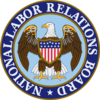About NLRB
Mark Gaston Pearce
Mark Gaston Pearce was sworn in as a Board Member on April 07, 2010, following his recess appointment, and was confirmed by the Senate on June 22, 2010. On August 23, 2013 he was sworn in for a second term that expires on August 27, 2018. He served as Chairman of the National Labor Relations Board from August 27, 2011- January 22, 2017.
Acquisitions
Our History
The National Labor Relations Board is proud of its history of enforcing the National Labor Relations Act. Starting in the Great Depression and continuing through World War II and the economic growth and challenges that followed, the NLRB has worked to guarantee the rights of employees to bargain collectively, if they choose to do so.
Leadership
Careers
The National Labor Relations Board (NLRB) is comprised of a team of professionals who work to assure fair labor practices and workplace democracy nationwide. Since its creation by Congress in 1935, this small, highly respected, independent Federal agency has had daily impact on the way America's companies, industries and unions conduct business.
The NLRB seeks astute, dedicated professionals in a variety of disciplines to carry out its mission nationwide. Use the information on the linked pages below to find out how you can be part of our team.
Background to election procedures rulemaking
On June 21, 2011, the National Labor Relations Board, Member Hayes dissenting, proposed reforms of the procedures it follows prior and subsequent to conducting a secret ballot election to determine if employees wish to be represented for purposes of collective bargaining. The proposed amendments are intended to reduce unnecessary litigation, streamline pre- and post-election procedures, and facilitate the use of electronic communications and document filing.
Boeing complaint background
On March 26, 2010, the International Association of Machinists and Aerospace Workers, District Lodge 751, filed a charge with the NLRB alleging that the Boeing Company had engaged in multiple unfair labor practices related to its decision to place a second production line for the 787 Dreamliner airplane in a non-union facility.
Specifically, the union charged that the decision to transfer the line was made to retaliate against union employees for participating in past strikes and to chill future strike activity, which is protected under the National Labor Relations Act.
The Right to Strike
Section 7 of the National Labor Relations Act (NLRA) states in part, “Employees shall have the right. . . to engage in other concerted activities for the purpose of collective bargaining or other mutual aid or protection.” Strikes are included among the concerted activities protected for employees by this section. The U.S. Supreme Court has upheld the right of employees to go on strike whether they have a union or not. Specifically, in 1962, the Supreme Court in NLRB v.
Pagination
- Previous page
- Page 27
- Next page

